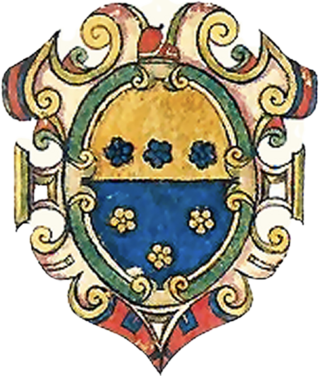Related Research Articles

The Duchy of the Archipelago, also known as Duchy of Naxos or Duchy of the Aegean, was a maritime state created by Venetian interests in the Cyclades archipelago in the Aegean Sea, in the aftermath of the Fourth Crusade, centered on the islands of Naxos and Paros. It included all the Cyclades. In 1537, it became a tributary of the Ottoman Empire, and was annexed by the Ottomans in 1579; however, Christian rule survived in islands such as Sifnos and Tinos.
Manuel Kantakouzenos was a Greek rebel leader who started a revolt against the Palaiologos family in the Byzantine Despotate of the Morea.
Chiara Zorzi or Giorgio, also Clara or Claire, was duchess consort of Athens by marriage to Nerio II Acciaioli, Duke of Athens, and regent of Athens during the minority of her son Francesco I from 1451 until 1454.
Florence Sanudo or Fiorenza, was Duchess of the Archipelago in 1362–1371, in co-regency with her second spouse.

The Frankokratia, also known as Latinokratia and, for the Venetian domains, Venetokratia or Enetokratia, was the period in Greek history after the Fourth Crusade (1204), when a number of primarily French and Italian states were established by the Partitio terrarum imperii Romaniae on the territory of the dissolved Byzantine Empire.
Cecilia Venier was suo jure lady of Paros in 1531-1537. She was the last ruler of Paros before it was conquered by the Ottoman Empire in 1537.
Crusino I Sommaripa was lord of the islands of Paros and later Andros in the Duchy of the Archipelago.

Nicholas III dalle Carceri, ninth Duke of the Archipelago and Lord of Euboea, was the only son of the first marriage of eighth Duchess Florence Sanudo, whom he succeeded in 1371, to Giovanni dalle Carceri, Lord of Euboea.
Maria Sanudo was lady of the island of Andros in the Duchy of the Archipelago in 1372–1383, and lady of the island of Paros and of one third of Negroponte in 1383–1426 in co-regency with her spouse, Gaspare Sommaripa.

Giacomo I Crispo was the eleventh Duke of the Archipelago, etc., from 1397 to 1418, son of the tenth Duke Francesco I Crispo and wife Fiorenza I Sanudo, Lady of Milos, and brother of John II and William II.

Giacomo II Crispo was the thirteenth Duke of the Archipelago, etc., from 1433 to 1447.
Gian Giacomo Crispo (1446–1453) was the fourteenth Duke of the Archipelago, etc., from 1447 to 1453, son of the thirteenth Duke Giacomo II Crispo and Ginevra Gattilusio.
Pietro Zeno, was lord of Andros from 1384 until his death in 1427, and a distinguished diplomat in the service of the Republic of Venice.

Giacomo IV Crispo was the last Duke of the Archipelago from 1564 to 1566.
Francesco III Crispo was the Duke of the Archipelago, ruling from 1500, when he succeeded John III Crispo after an interregnum. He was succeeded in 1517 by John IV Crispo, after an interregnum that began in 1511.
Francesco II Crispo was the sixteenth Duke of the Archipelago, ruling for less than one year in 1463 when he succeeded his uncle William II Crispo. He was succeeded in 1463 by his son Giacomo III Crispo under the regency of his widow Petronilla Bembo.
Giacomo III Crispo, was the seventeenth Duke of the Archipelago, ruling from 1463 when he succeeded Francesco II Crispo. He was succeeded in 1480 by Giovanni III Crispo.
Petronilla Bembo, was a Duchess consort of Naxos by marriage to Francesco II Crispo.
Domenico Pisani was a Venetian nobleman and briefly the lord of the Aegean island of Santorini in 1479–1480.

The House of Loredan-Santa Maria is a cadet branch of the noble House of Loredan which has produced many politicians, diplomats, military generals, naval captains, church dignitaries, writers and lawyers, and has played a significant role in the creation of modern opera with the Accademia degli Incogniti, also called the Loredanian Academy. The branch draws its name from the parishes of Santa Maria Formosa and Santa Maria dei Miracoli in Venice, around which it was historically settled. The progenitor of the branch is considered to be the famous admiral and procurator Pietro Loredan (1372-1438) by his sons Giacomo and Polo.
References
- ↑ Miller, William. The Latins in the Levant: A History of Frankish Greece (1204–1566). London: 1908.
- ↑ Miller, William. The Latins in the Levant: A History of Frankish Greece (1204–1566). London: 1908.
- ↑ Miller, William. The Latins in the Levant: A History of Frankish Greece (1204–1566). London: 1908.
- ↑ Miller, William. The Latins in the Levant: A History of Frankish Greece (1204–1566). London: 1908.
- Miller, William. The Latins in the Levant: A History of Frankish Greece (1204–1566). London: 1908.